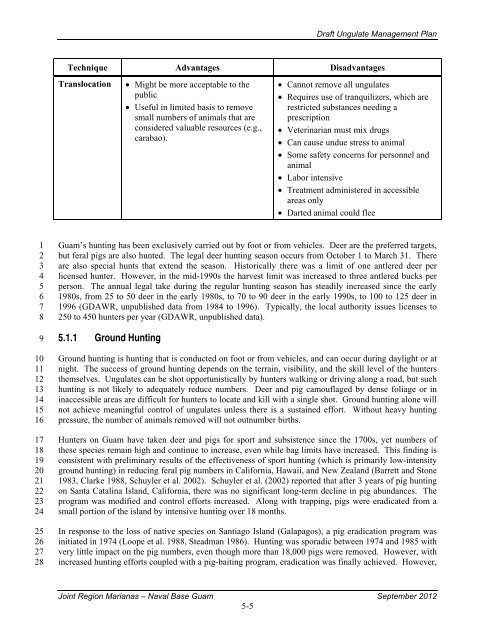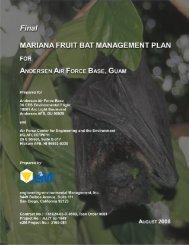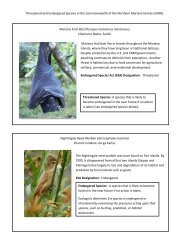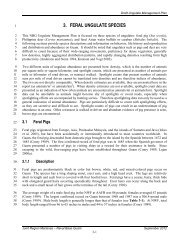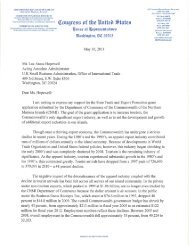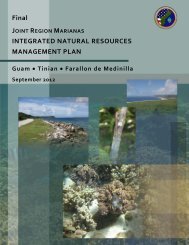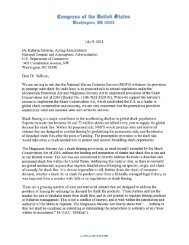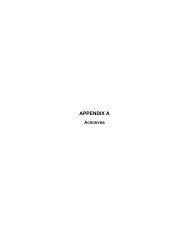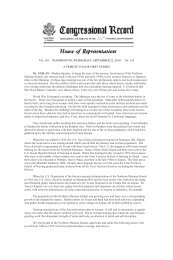4. FERAL UNGULATE SPECIES IMPACTS ON NAVY LANDS
4. FERAL UNGULATE SPECIES IMPACTS ON NAVY LANDS
4. FERAL UNGULATE SPECIES IMPACTS ON NAVY LANDS
Create successful ePaper yourself
Turn your PDF publications into a flip-book with our unique Google optimized e-Paper software.
1<br />
2<br />
3<br />
4<br />
5<br />
6<br />
7<br />
8<br />
9<br />
10<br />
11<br />
12<br />
13<br />
14<br />
15<br />
16<br />
17<br />
18<br />
19<br />
20<br />
21<br />
22<br />
23<br />
24<br />
25<br />
26<br />
27<br />
28<br />
Draft Ungulate Management Plan<br />
Technique Advantages Disadvantages<br />
Translocation Might be more acceptable to the<br />
public<br />
Useful in limited basis to remove<br />
small numbers of animals that are<br />
considered valuable resources (e.g.,<br />
carabao).<br />
Cannot remove all ungulates<br />
Requires use of tranquilizers, which are<br />
restricted substances needing a<br />
prescription<br />
Veterinarian must mix drugs<br />
Can cause undue stress to animal<br />
Some safety concerns for personnel and<br />
animal<br />
Labor intensive<br />
Treatment administered in accessible<br />
areas only<br />
Darted animal could flee<br />
Guam’s hunting has been exclusively carried out by foot or from vehicles. Deer are the preferred targets,<br />
but feral pigs are also hunted. The legal deer hunting season occurs from October 1 to March 31. There<br />
are also special hunts that extend the season. Historically there was a limit of one antlered deer per<br />
licensed hunter. However, in the mid-1990s the harvest limit was increased to three antlered bucks per<br />
person. The annual legal take during the regular hunting season has steadily increased since the early<br />
1980s, from 25 to 50 deer in the early 1980s, to 70 to 90 deer in the early 1990s, to 100 to 125 deer in<br />
1996 (GDAWR, unpublished data from 1984 to 1996). Typically, the local authority issues licenses to<br />
250 to 450 hunters per year (GDAWR, unpublished data).<br />
5.1.1 Ground Hunting<br />
Ground hunting is hunting that is conducted on foot or from vehicles, and can occur during daylight or at<br />
night. The success of ground hunting depends on the terrain, visibility, and the skill level of the hunters<br />
themselves. Ungulates can be shot opportunistically by hunters walking or driving along a road, but such<br />
hunting is not likely to adequately reduce numbers. Deer and pig camouflaged by dense foliage or in<br />
inaccessible areas are difficult for hunters to locate and kill with a single shot. Ground hunting alone will<br />
not achieve meaningful control of ungulates unless there is a sustained effort. Without heavy hunting<br />
pressure, the number of animals removed will not outnumber births.<br />
Hunters on Guam have taken deer and pigs for sport and subsistence since the 1700s, yet numbers of<br />
these species remain high and continue to increase, even while bag limits have increased. This finding is<br />
consistent with preliminary results of the effectiveness of sport hunting (which is primarily low-intensity<br />
ground hunting) in reducing feral pig numbers in California, Hawaii, and New Zealand (Barrett and Stone<br />
1983, Clarke 1988, Schuyler et al. 2002). Schuyler et al. (2002) reported that after 3 years of pig hunting<br />
on Santa Catalina Island, California, there was no significant long-term decline in pig abundances. The<br />
program was modified and control efforts increased. Along with trapping, pigs were eradicated from a<br />
small portion of the island by intensive hunting over 18 months.<br />
In response to the loss of native species on Santiago Island (Galapagos), a pig eradication program was<br />
initiated in 1974 (Loope et al. 1988, Steadman 1986). Hunting was sporadic between 1974 and 1985 with<br />
very little impact on the pig numbers, even though more than 18,000 pigs were removed. However, with<br />
increased hunting efforts coupled with a pig-baiting program, eradication was finally achieved. However,<br />
Joint Region Marianas – Naval Base Guam September 2012<br />
5-5


